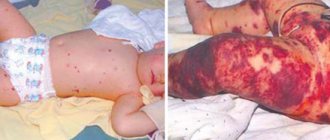Meningitis is a dangerous infectious disease that affects the meninges. It can be bacterial, fungal or viral in nature. Viral meningitis is also called serous meningitis and causes inflammation of the brain and spinal cord. Serous meningitis occurs most often in the summer, which is associated with the seasonality of some viral diseases. However, the risk of infection at other times of the year cannot be excluded. When the first signs of meningitis appear, it is important to consult a doctor as soon as possible.
At the Yusupov Hospital, the patient will be provided with all the necessary medical care: they will conduct an examination and prescribe adequate treatment. Experienced doctors at the Yusupov Hospital can quickly determine the type of disease and, without wasting time, begin therapy, which will reduce the risk of complications.
Causes
More than 60% of cases of serous meningitis are caused by enteroviruses, which are the main causative agents of viral meningitis. Infectious agents that cause inflammation of the meninges include:
- enteroviruses (70-80% of cases);
- arboviruses;
- Coxsackie viruses type A and B;
- parotitis;
- togaviruses;
- HSV type 2;
- cytomegalovirus;
- adenoviruses
The incidence of viral meningitis increases sharply in the summer. Rotavirus meningitis develops extremely rarely.
Methods of distribution depending on the species
Whether meningitis is contagious or not depends on its form. This also affects the severity of symptoms and the severity of the pathology.
Bacterial
Pathogen bacteria can live in the nasopharynx for up to several years, and begin to cause harm only after entering the blood. Pathogenic organisms are transmitted through liquids (saliva, mucus). The typical route of transmission is airborne (contagious to humans).
Viral
The causative agent is enterovirus. Infection occurs by airborne droplets or contact. If the infection is on the mucous membrane of the eye, in the mouth, on the skin, then it easily spreads to surrounding objects (by touching them, a person becomes infected). The virus can also enter the body by swimming in polluted waters (rare cases). Other possible routes of transmission:
- transmissible (carried by insects);
- vertical (from mother to child during childbirth).
Parasitic (amoebic)
This is a rare form that most often ends in death. The causative agent is Naegleria fowlera, which lives in water (freshwater lakes, poorly chlorinated pools). The pathogen enters the human body through the nose. It is not transmitted from person to person.
IMPORTANT: At high temperatures, the risk of developing this form of meningitis increases. In hot weather, you should not swim in fresh water
Important Removal of adenoids in children: how the operation is performed, review of reviews, whether it needs to be removed, indications, whether the procedure hurts, methods and methods, at what age it is done
Fungal
They provoke the onset of candida and coccidia. Anyone can become infected, but people who take hormones or receive chemotherapy, as well as people with HIV, are especially susceptible. The infection from the primary focus, along with the blood flow, enters the brain and inflammation begins. The fungal form is not contagious.
Non-infectious
It is not transmitted from person to person. The disease can develop after removal of brain tumors, treatment of various pathologies of the nervous system. The mechanism of appearance is a response to intervention in the central nervous system. Provoking factors – oncology, trauma, some groups of drugs.
Symptoms
The incubation period for viral meningitis usually lasts 2-4 days.
The disease begins acutely, with high fever and general intoxication. In patients with high body temperature, malaise increases, muscle and joint pain, nausea and vomiting, abdominal pain, and diarrhea appear. Slight drowsiness and stupor are often associated. More severe signs of meningitis (impaired consciousness, stupor and coma) are not typical for inflammation of the meninges caused by viruses and require a more in-depth examination of the patient. From the first or second day of the disease, doctors determine a clearly defined meningeal syndrome:
- severe headache;
- repeated vomiting;
- lethargy and drowsiness, sometimes agitation and anxiety.
Patients may complain of cough, runny nose, sore throat and abdominal pain.
Often, patients with viral meningitis develop skin hyperesthesia (increased sensitivity to various irritants). On examination, neck rigidity and signs of severe hypertensive cerebrospinal fluid syndrome are revealed. During a lumbar puncture, clear, colorless cerebrospinal fluid flows out under pressure. An increased content of lymphocytes is determined in the cerebrospinal fluid, while the levels of protein, glucose and chlorides are within normal limits. After 3-5 days, body temperature normalizes. Sometimes a second wave of fever appears. In patients with viral meningitis, the following meningeal signs are determined:
- Kernig's symptom - the patient cannot straighten the leg bent at a right angle;
- Brudzinski's symptom: lower (when trying to straighten one bent leg, a reflex flexion of the second leg occurs), and upper - when bending the head, involuntary flexion of the lower limb occurs;
- Babinski's symptom - dorsiflexion of the first toe occurs with streak irritation of the plantar surface of the foot.
In most adults, viral meningitis occurs without complications. Some recovering patients complain of headaches for several weeks or months. They have mild intellectual impairment, asthenia or impaired coordination of movements. The prognosis for newborns and infants is not clear. They may have persistent complications in the form of intellectual impairment, learning difficulties, and hearing loss.
Symptoms and diagnosis of meningitis
Regardless of the cause of the disease, the classic symptoms of meningitis are the same and are associated with irritation of the meninges. However, the onset of the disease may differ.
The first symptoms are a rise in temperature to 38°C or higher, headache, nausea and vomiting. Vomiting can be repeated, bringing no relief, indomitable. Almost simultaneously, rigidity (tension) of the muscles in the back of the neck appears, while the head is thrown back.
Headache of a bursting, pressing nature, unquenchable with painkillers. Consciousness quickly becomes confused/depressed.
Convulsions begin immediately or after a while. The nature and location of seizures depends on which area of the brain is most affected. Local and widespread forms of meningitis are possible.
Meningitis often develops into meningoencephalitis, that is, when not only the membranes of the brain are affected, but also the brain matter itself. The prognosis for meningoencephalitis is unfavorable.
Meningococcal meningitis can occur as bacterial meningitis itself, meningoencephalitis, meningococcal sepsis, and a mixed form - meningoencephalitis and sepsis. Sometimes the disease can occur in an atypical manner, affecting the lungs, heart, joints, and eyes.
Stages of meningitis
The beginning of meningococcal meningitis is a common runny nose, but with pronounced purulent discharge of a greenish-yellow color. When examining the pharynx, two/one purulent tracks are visible on the wall of the pharynx; the pus simply flows into the throat. In this case, a runny nose may or may not be accompanied by a fever. At this time, a person is very contagious, but he himself may feel normal. At this stage, chronic meningococcal nasopharyngitis and carriage may develop, or the disease moves to the next stage.
A detailed clinical picture of meningitis with pronounced cerebral symptoms can be supplemented by spots on the skin if meningococcus has entered the blood and spread throughout the body. Meningococcal sepsis most often begins with a rash on the thighs and abdomen, which looks like hemorrhages in the skin of varying sizes. But soon, without adequate antibacterial therapy, it spreads throughout the body.
If a person does not receive suitable/any treatment, meningococcal sepsis most often ends in death.
Diagnosis of meningitis
- Collecting anamnesis (what happened before the onset of the disease), analysis of symptoms
- Neurological examination
- Examination by a surgeon
- Analysis of discharge from the throat and nose for meningococcus
- Blood test, blood culture on a nutrient medium if sepsis is suspected
- Spinal puncture, fluid analysis, culture of cerebrospinal fluid on a nutrient medium
- If meningococci and other bacteria have not been isolated, and the doctor suspects infectious meningitis, a blood test for antigens to viruses
- MRI/CT of the brain and spinal cord, assessment of the condition of the cerebral ventricles, membranes and surrounding space, the amount of cerebrospinal fluid, the condition of brain tissue
If the diagnosis of meningococcal meningitis is confirmed, everyone who had contact with the patient is taken under observation and remains in quarantine. The patient is transported to an infectious diseases hospital in a closed box, all contacts with him are strictly limited to prevent the spread of infection.
Diagnostics
The diagnosis of viral meningitis can be reliably established or refuted by examining the cerebrospinal fluid.
A large number of lymphocytes and a slightly elevated protein level with normal glucose concentrations are detected in the cerebrospinal fluid. An indirect sign of the viral nature of meningitis is the absence of the pathogen in cerebrospinal fluid smears of any type of color. In the first 48 hours of illness, especially in some enterovirus infections and meningitis caused by eastern equine encephalomyelitis virus or ECHO virus 9, cytosis may be predominantly neutrophilic. In this case, the spin fluid analysis is repeated after 8-12 hours and it is monitored whether a lymphocytic shift has appeared. If neutrophils are present in the cerebrospinal fluid, an additional examination is performed to exclude bacterial meningitis or the presence of a focus of infection near the meninges.
Cytosis in viral meningitis does not exceed 1000 in one microliter of cerebrospinal fluid. Glucose levels are normal in most cases, but may be decreased in meningitis caused by the mumps virus, inflammation of the meninges caused by ECHO viruses and other enteroviruses, herpes simplex virus type 2, Varicella-zoster virus, or lymphocytic choriomeningitis. More often, lymphocytosis with low glucose levels is evidence of fungal, tuberculous or listeria meningitis or a non-infectious disease (sarcoid meningitis and diffuse tumor infiltration of the meninges).
Isolating the virus from cerebrospinal fluid is technically difficult. Adenoviruses and enteroviruses can be detected in feces, arboviruses in blood, mumps virus and cytomegalovirus in urine. Enteroviruses, mumps virus and adenoviruses are detected in nasopharyngeal swabs.
An important method for diagnosing viral meningitis is the detection of viral DNA or RNA using polymerase chain reaction (PCR). This method allows the detection of herpes simplex virus DNA in the cerebrospinal fluid of patients with Mollaret meningitis or herpetic encephalitis, even with negative culture results. PCR is widely used to detect Varicella Zoster virus, cytomegalovirus, and Epstein-Barr virus. This is the method of choice for detecting picornaviruses (poliomyelitis, Coxsackie, ECHO viruses) in the cerebrospinal fluid of patients suffering from meningitis.
Diagnosis of viral meningitis is carried out using electrophoresis of cerebrospinal fluid in agarose gel or isoelectric focusing of gamma globulins. These methods make it possible to identify oligoclonal immunoglobulins in meningitis caused by:
- human immunodeficiency virus;
- Human T-lymphotropic virus type 1;
- Varicella Zoster virus;
- mumps virus.
An increase in immunoglobulin titer is often accompanied by the appearance of antibodies to viral proteins.
Identification of oligoclonal immunoglobulins helps to carry out differential diagnosis, since they are absent in viral meningitis caused by enteroviruses, arboviruses and herpes simplex virus. Each patient with suspected viral meningitis at the Yusupov Hospital undergoes:
- general blood analysis;
- biochemical studies of liver function;
- determination of hematocrit, erythrocyte sedimentation rate, nitrogen and urea levels in the blood;
- determination of electrolytes and blood plasma glucose, creatinine, amylase and lipase.
Changes in certain indicators make it possible to clarify the nature of the disease.
Disease prevention
Prevention of meningitis can be divided into specific and nonspecific.
| Specific | Nonspecific |
| - Chemoprophylaxis is carried out for everyone who has had close contact with the bacteria carrier. For this purpose, rifampicin is used; in children under two years of age and pregnant women - ceftriaxone; -Vaccination (meningococcal, pneumococcal vaccines are used in children from 1 to 8 years). Compliance with the vaccination schedule prevents the development of many diseases. In childhood, vaccinations are also carried out against measles, mumps, measles rubella, and chickenpox. | -Strengthening the immune system (physical activity, fresh air); -Compliance with personal hygiene rules; -Daily ventilation, wet cleaning; -Limiting contact with bacteria carriers; -During epidemics, try to avoid crowded places; - Thorough washing of fruits, vegetables, berries before consumption; -Vitamin therapy. |
Prevention of meningitis also involves isolating the active bacteria carrier. Such patients being treated in infectious diseases departments are placed in boxes. After hospitalization of the patient within 24 hours, a doctor must examine all persons who had contact with him. When individuals with acute nasopharyngitis are identified, they are advised to undergo a more thorough examination, including bacteriological examination to identify meningococcus, make a diagnosis and begin treatment as early as possible.
Important information
Meningitis is an essential nosological entity in diseases of both adults and children. Timely diagnosis allows you to avoid serious complications.
Since the disease can begin with nasopharyngitis - it is often similar in clinical picture to ARVI, consultation with a specialist is necessary to make the correct diagnosis and prescribe treatment.
FAQ
Treatment
At the Yusupov Hospital, doctors provide treatment for viral meningitis, aimed at preventing or limiting the formation of irreversible damage to the brain. To destroy pathogens of viral infection, patients are prescribed the following medications:
- recombinant α-interferon;
- inducers of endogenous interferon (neovir, cycloferon);
- RNase;
- intravenous immunoglobulins (intraglobin F).
Antiviral drugs are prescribed from 2 to 5 days of illness or in severe condition of a patient with viral meningitis.
In severe cases of the disease, glucocorticoids are used during the first 2-3 days of the disease: dexamethasone or prednisolone. If the patient develops complications, antibacterial drugs are prescribed. For serous meningitis caused by a virus or Epstein-Barr, acyclovir is prescribed. For immunocompromised patients, immunoglobulin is administered intravenously. To reduce intracranial pressure, furosemide, Lasix or acetazolamide are prescribed. With severe cerebral edema, treatment with mannitol is started. Detoxification therapy is carried out with glucose solution, rheopolyglucin, albumin, plasma. Crystalloid and colloid solutions are administered intravenously.
When the body temperature is above 38 degrees, antipyretics are used - paracetamol, ibuprofen. All patients with serous meningitis at the Yusupov Hospital are prescribed drugs that improve the metabolism of cells of the central nervous system: piracetam, nootropil, picamilon. To reduce the energy deficit of the brain and improve tissue metabolism in viral meningitis, ascorbic acid and riboxin are prescribed. In severe cases of the disease, antioxidants are prescribed - cytomol, cytochrome. From the first day of therapy, all patients with viral meningitis are prescribed drugs that improve cerebral circulation (Cavinton, dipyridamole).
How is viral meningitis transmitted?
Serous, aseptic meningitis is a contagious inflammatory process that previously had a high epidemiological threshold in connection with polio diseases. Since the 60s of the last century, epidemic outbreaks have become much less common, thanks to widespread vaccination against polio. However, in the summer and early autumn, isolated forms of meningitis are regularly recorded, mainly among young children.
Important Cough after eating: why it starts in a child, causes of attacks in adults, which doctor to consult
How is viral meningitis transmitted? There is only one answer - only by contact through the nose or mouth. The source of infection is always a sick person - a virus carrier; the route of transmission is most often airborne, less often - oral-fecal. Very rarely, viral meningitis is transmitted through the placental route, that is, from an infected mother to the fetus. Depending on the route of infection, the virus can enter either the digestive tract or the nasopharynx, causing inflammation of the pharynx, respiratory system, and, less commonly, abdominal pain. Penetrating into the bloodstream, the virus enters the serous membranes of the brain, but rarely penetrates into the cerebrospinal fluid and cerebrospinal fluid.
Viral meningitis is transmitted in the following ways:
- Saliva.
- Sputum when coughing.
- Nasal mucus when sneezing, blowing nose.
- Feces (rarely).
The main route of transmission of meningitis in children is through dirty hands that have had contact with objects infected with the virus, infected people (hugs, kisses, etc.). You can also become infected through virus-contaminated water and food. When in contact with a sick person, an adult is most often at risk of contracting a viral infection, but not meningitis; children are more susceptible to this disease because their immune system is still developing.
Prevention
To avoid getting viral meningitis, you should not swallow water while swimming in open water.
You should observe the rules of personal hygiene and thoroughly wash vegetables and fruits before eating. To prevent influenza, vaccination is carried out. If you have signs of viral meningitis, call the Yusupov Hospital. Doctors examine patients using equipment from leading European and American companies. To treat patients, neurologists use effective antiviral drugs that have a minimal range of side effects.
Make an appointment
Prevention for meningitis
It is always easier to prevent a disease than to fight it. To prevent chronic meningitis, vaccination is usually used.
Vaccination is carried out against meningococcal and hemophilic meningitis, preventing damage to the meninges. If infections in a child are not eliminated, this can lead to the development of bronchitis, acute respiratory infections, and pneumonia. Preventive measures should be carried out for children who are prone to frequent illnesses and those who have had contact with a carrier of hemophilus influenzae infection.
Editor's note: How to get rid of headaches due to a cold
There are additional preventive measures:
– compliance with simple hygiene rules. Be sure to wash your hands, especially after contact with an infected patient;
– where a sick person is located, it is necessary to ventilate the room, eliminating the possibility of infection of a healthy body;
– whenever possible, always avoid contact with people who are infected;
To prevent meningitis, use regular hardening procedures as a preventive measure: sports, water treatments. It would be beneficial for the body to use modern therapy for acute and chronic infectious diseases. So, where there is a risk of meningococcal meningitis (schools, kindergartens), undergo a short course of treatment with drugs to strengthen and improve immunity (ginseng, eleutherococcus).
Which doctor treats chronic meningitis?
To make an accurate diagnosis, only qualified specialists are needed: a neurologist and an infectious disease specialist. You should contact them not only for help, but also to receive the right advice. Chronic meningitis is a serious disease and should be treated as responsibly as possible, because the consequences can be very serious. Untreated meningitis can lead to death. Remember this!
Restoring the body after undergoing treatment will take quite a long time, and for the patient this seems to be the most crucial moment: you need to be patient, both for him and for those close to you. Be sure to follow all medical recommendations.
Author of the material: Ivanova M.S.
Tags: chronic meningitis, symptoms of chronic meningitis, treatment of chronic meningitis
Incubation period of viral meningitis and consequences of the disease
In almost every person, the mention of meningitis causes panic, and for good reason. Viral meningitis, like any disease of the nervous system, poses a great danger to human health and life, although it is not as serious as, for example, bacterial meningitis.
Doctors say that with timely initiation of treatment, complications can be avoided. To do this, it is necessary to diagnose the disease as early as possible, because its consequences can be irreversible for the patient or lead to his death.
Definition and routes of infection
Meningitis is a disease that affects the membranes of the brain and spinal cord and is inflammatory in nature, triggered by an infection with weak immunity.
The following routes of infection are distinguished:
- Airborne. The infection enters the body through breathing along with air and dust particles.
- Contact. Infection of the meninges directly during head injuries with a skull fracture and operations without proper sterilization of instruments.
- Hemo- and lymphogenous. The pathogen is transported to the meninges by blood and lymph.
- Infection from blood-sucking insects.
A separate method is the transmission of infection from mother to fetus through the placental barrier.
Depending on the occurrence there are:
- Primary meningitis occurs on its own.
- Secondary meningitis is a complication of an existing source of inflammation due to the spread of infection.
Incubation period of viral meningitis
The incubation period is the time between the moment the infection enters the body and the appearance of the first signs characteristic of the disease. During this period, pathogenic microorganisms multiply and penetrate organs and tissues.
The incubation period for infection with viral meningitis in adults is short and ranges from two to four days. For children, this period of time increases to 2–10 days.
Consequences and complications
Viral (infectious) meningitis is a dangerous disease that leads to the development of complications if treated incorrectly or insufficiently. Consequences and complications differ between children and adult patients.
In children
The consequences of the disease in children manifest themselves in the following forms:
- asthenic syndrome;
- decreased memory and attention;
- impaired coordination of movements;
- hearing loss;
- delayed intellectual development;
- mental disorders.
In adults
For adults, viral meningitis is less dangerous, but it causes the following consequences:
- headache;
- lethargy;
- emotional instability.
Is death possible?
This disease was and remains quite dangerous. However, mortality from it has decreased to 10% of cases. This is due to the fact that treatment has become more effective and timely.
Rehabilitation course
A patient who has suffered meningitis is required to undergo rehabilitation for two years. Depending on the severity of the disease, the period may increase. During this time, the patient is under the supervision of a neurologist. The sanatorium treatment also worked well.
The rehabilitation course includes the following blocks:
- diet;
- physical exercise;
- physiotherapy;
- cognitive therapy.
Main objectives of rehabilitation:
- strengthening the immune system;
- restoration of intellectual functions;
- muscle relaxation after stiffness;
- general strengthening of the body.
In addition, with disability due to meningitis, occupational therapy is required to adapt the patient to new living conditions and restore everyday skills. Viral meningitis occurs as a result of a viral infection in the body. Thanks to timely and competent treatment, the prognosis of this disease is favorable, and mortality has been reduced to 10%.
And if you have a question that is beyond the scope of this topic, use the button above.







